
When Total Motorcycle was given the opportunity to review two Camelon Plus automatic chain oilers, the first question was that of relevance. Do owners need the product? Do they already use the product? And would they benefit from the product? As it turns out, chain maintenance is a lot like preventative dental care. Most of us probably aren’t doing enough of it. Eric Leaverton reviews.
In a casual poll of fellow riders conducted via social media, only 30% of respondents stated they cleaned and lubricated their chain as much as or more than their owners manual recommended. By comparison, 58% are performing only occasional chain maintenance, and another 12% do little or no maintenance on their chain at all. One comedian stated they just “buy new eBay chains as needed” as part of their maintenance routine. Exactly 0% responded that they were already using a device like the Camelon Plus. All this means that roughly 7 in 10 riders aren’t getting as many miles out of their drive chain as they could be. Relevant? In spades.
Cameleon Plus Electronic Oiler System
Manufactured By: Cameleon Solutions, Québec, Canada
Reviewed by: Eric and Carrie Leaverton
Location: Harrisville, Utah, USA
Review Dates: December 18th 2017 – March 30th 2018
Price as Tested: $210.00 USD
Manufacturers Website: Cameleon Oiler
Overview
The Cameleon PLUS electronic chain oiling system is a self-contained, automatic chain oiling device for motorcycles. It is a smart system that will oil automatically based on the ambient temperature and it consists of three primary components: the device itself, a hose-type oil reservoir, and the tube that delivers the oil to the chain. Two separate pieces comprise the output tube, a flexible portion permanently attached to the device and a semi-rigid portion designed to attach to the swing arm. A barbed connector affixed to the rigid end connects the two components, allowing for secure attachment to the bike while still compensating for suspension travel.
The Cameleon Plus is designed to be powered by the vehicle’s electrical system and comes with several connectors for that purpose. Oil delivery is microprocessor-controlled and can be adjusted for lighter or heavier oiling as preferred. You also get automatic flow adjustment based on ambient temperature and a manual over-oiling mode for wet or challenging conditions, features that are absent on the base oiling system.
Finally, Cameleon makes a proprietary 100% synthetic SAE-190 chain oil, marketed under the name CCO (Cameleon Chain Oil). The manual for the Cameleon Plus oiler recommends you only use their blend, and use of any other oil will void the 3-year limited warranty they offer.
Contents and Measurements
The Cameleon Plus comes packaged in a crimped plastic clamshell. Inside you will find the device itself, several heavy-duty zip-ties, three vinyl-coated hose brackets, several solderless quick-splice connectors and the manual. This kit comes pre-loaded with 250ml of Cameleon’s proprietary chain oil (CCO), which is enough for roughly 4,000 miles of use. Additional bottles of CCO can be had for $20.
The Cameleon Plus is a small device, measuring 2.75” (10cm) long, 1.75” (4.5cm) tall and 1.25” (3cm) thick. A vaguely triangular clear LED projects from the front, and the device narrows slightly towards the back. The reservoir tube is roughly .5” (13mm) in diameter and 36” (91cm) long. Stranded 20ga wires provide the electrical connection and are sheathed together for convenience, measuring about 40” (102cm). The 20ga flexible output tube measures roughly 24” (61cm), and is designed to be trimmed on installation. The semi-rigid tube consists of a 20ga steel rod and loose vinyl sheath. Oil flows along the rod inside the sheath and drips from the end. It measures roughly 18” (46cm) and is also meant to be trimmed for installation. All components are black except for the reservoir tube and the LED, which are clear.


Installing the Cameleon Plus
Installing the Cameleon Plus was a fairly uncomplicated task, and took less than an hour to complete. No special tools were required to complete the installation, but it did require a measure of commitment and confidence. More on that later.
On our first test bike, a Versys 650, the supports for the passenger footpegs proved an ideal mounting location. Two channels on top of the device provide for simple zip-tie connections, and we utilized them with great success. The reservoir tube routes up underneath the seat near the battery box and tucks nicely into the tailpiece.
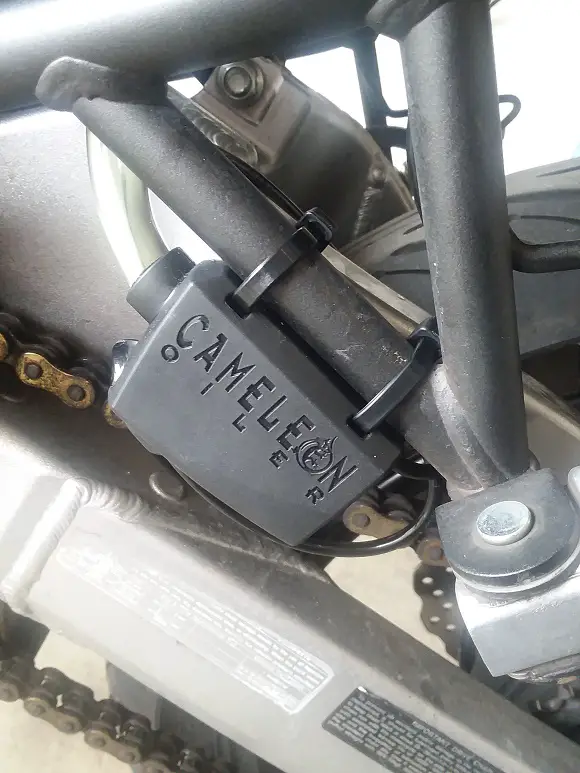 |
 |
Installation on our second test bike, a Ninja 650, was a little more difficult. There weren’t any tubular frame components the device could hang from, as on the Versys, so we had to get creative. As is often the case in unorthodox mounting situations, 3M came to our rescue. We found a suitable surface behind the side cover and applied some Dual-Lock fastener strip, which worked perfectly. We had to mount the Camelon Plus vertically to avoid kinking the reservoir tube, but it works fine.
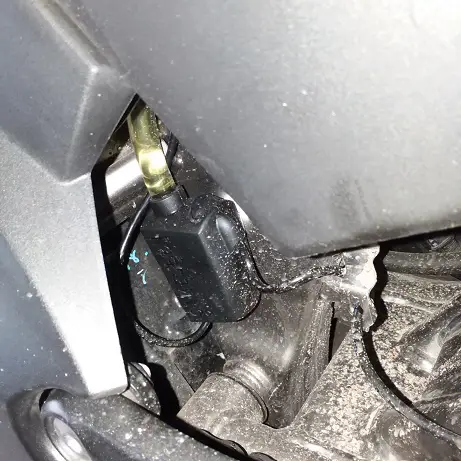 |
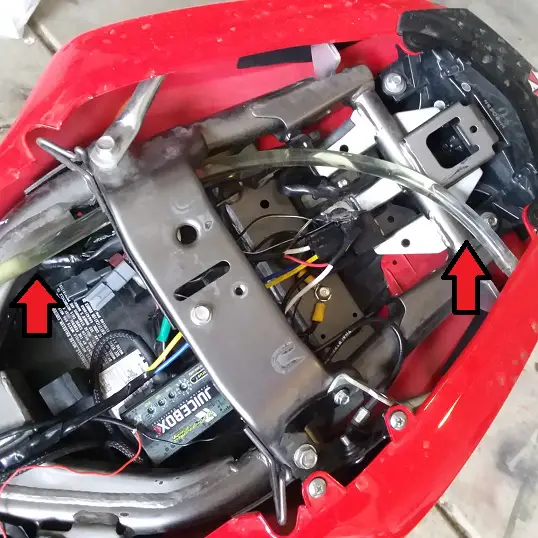 |
Wiring up our devices was a little different than the manual suggests. Cameleon provides solderless quick-splice connectors, and they recommend splicing into your license plate lamp for power. This is sound advice, as this circuit isn’t critical to safe operation and isn’t energized when the key is off. However, we’ve installed auxiliary fuse boxes on our test bikes and we used them to power the Cameleon Plus. These fuse boxes are energized by a switched relay slaved to the plate lamp, and we’re using 10a fuses on the circuit.
If you’d like to wire up your own switched relay, but aren’t sure just how, here’s an excellent YouTubevideo on the topic.
I mentioned earlier that there was some commitment and confidence necessary to install the Cameleon Plus. This comes into play when it’s time to install the swing arm tube. The manual states the end of the tube should be positioned roughly 1 inch (25mm) from the chain where it meets the rear sprocket. While you could use the provided zip ties to affix the rigid tube to your swing arm, relying on plastic fasteners to suspend a 20ga steel rod so close to such sensitive components is a little frightening. Instead, I visited my tool crib. Convincing myself to drill holes in “hard parts” took some effort, but in the end it was the right choice. I used the sheet metal screws and crimp tube fasteners provided, and the results speak for themselves.
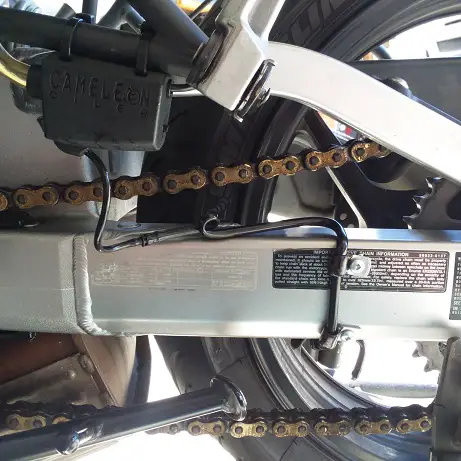 |
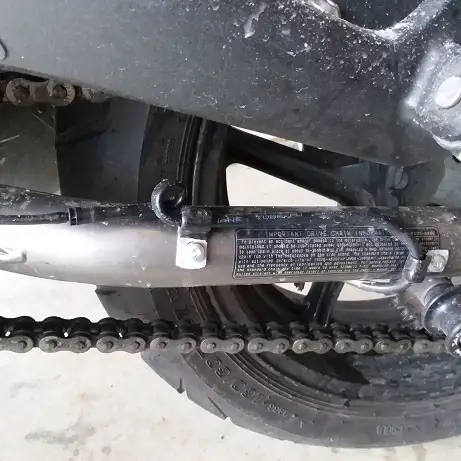 |
To trim the tube I first used wire strippers to remove the excess sheathing, then used a high-speed rotary tool with a cutoff wheel to truncate the steel rod inside. You could just use the rotary tool for the entire process, but your cutoff wheel will melt through the sheathing and leave an untidy end (not guessing here, trust me!). Cutting them separately allows for a clean, professional look.
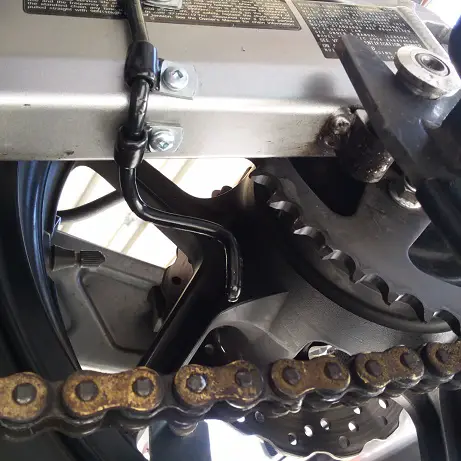 |
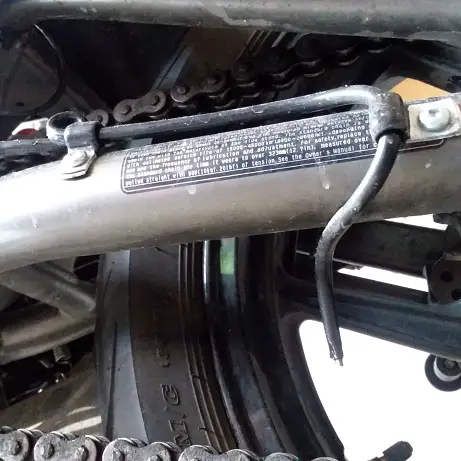 |
Bending the tube to match the curvature of your swing arm can also be a little difficult. I used two small box wrenches to brace and apply leverage, and PVC pipe to create the necessary radii. This method provided excellent results.
Once the rigid tube is properly positioned and secured to the swing arm, all that’s left to do is route the flexible tube to it. Make sure to leave enough excess length to allow for suspension travel, especially for off-road applications. I trimmed the flexible tube with simple scissors. Take care to get the end fully over the barbed connector to prevent any leakage.
Setting the Cameleon Plus
Once you’ve installed your Cameleon Plus, the final step is to set it. Here the manual can leave you a little stumped, as the translation (presumably from French) isn’t perfect. The way it’s worded, you may try to set the device once you’ve already started your bike. Don’t. Press and hold the settings button, and with it held in switch on your ignition. The LED will turn red and flash seven times, then pause, then flash seven times again. You set it by releasing the button after as many flashes as you want to set it to. That is, if you release after one flash you’ve set the device to “1”, after two flashes you’ve set it to “2”, and so on up to 7. The higher the setting, the more oil it will release during it’s lubrication cycle. The default setting out of the box is 4.
Operation
The Cameleon Plus needs no more input and operates independently once it’s been set. It will perform a 30-second lubrication cycle every three minutes forty-five seconds. Again, the higher it’s been set the more oil it releases during those 30 seconds. The LED turns green during the lubrication cycle, then back to a steadily pulsing blue when it’s in standby. While we have yet to do a comprehensive timing of each setting, the manual seems to suggest six drops per cycle at the highest setting under normal conditions.
We say “under normal conditions” because the Cameleon Plus is an intelligent system. It automatically restricts the amount of flow based on ambient temperature, releasing less oil in warmer conditions. It also restricts flow when the vehicle slows down or stops. The last autonomous adjustment it can make is for rough riding conditions. If the unit detects an abnormal amount of vibration, it will increase flow from an extra 1% – 10% depending on severity.
You can also adjust for heavier flow on the fly with what the Cameleon Plus calls “Trek” mode. At any time during regular operation, you can press and release the settings button to get double lubrication. Do it again, and you’ll get triple lubrication. The LED blinks twice every five seconds to indicate it’s doubling, and three times every five seconds to indicate tripling. You cancel Trek mode by pressing the settings button for seven seconds, or by switching the ignition off and then on again.
Conclusions
It’s my practice to get some input from fellow enthusiasts anytime I’m starting a new review, and this was no exception. By far, the most often repeated sentiment among my friends was some variation of “what if it sprays oil all over the place?” I heard horror stories about someone’s 1947 H-D with a similar device. People recommended making sure I could disconnect the power to the Cameleon Plus easily in case of a malfunction, and even assuming it didn’t malfunction I heard dire warnings about the chain flipping oil all over everything. There was also a lot of concern about whether or not it would drain my battery, despite my assurances that the auxiliary fuse block would make this impossible.
In lieu of all that, I think it’s safe to say there’s a lot of mistrust in this sort of product. My experience so far with Cameleon Plus, though, suggests most of those concerns are unfounded. We’ve driven more than 300 miles with the system installed and have yet to notice any stray oil anywhere on the frame, tire, or our clothing. The manual states that the device may occasionally release a drop after it’s been shut down, a result of tube dilation and temperature, and it does occasionally deposit a drop of oil on the floor of my garage. This is only because the tube isn’t directly over the chain when the bike is leaned over on the kickstand. If we were using a wheel chock or rear stand, those errant drops would never make it to the ground.
So does the Cameleon Plus work? There really isn’t a lot to get wrong here. I’ve checked the chain after every ride and it stays clean and well oiled. The device does what it says it does, and does so without any muss or fuss. It’s an attractive component, it was easy to install and operates flawlessly.
There are less expensive options available, and the Cameleon Plus is one of the most expensive oilers you can buy. Some of the less expensive options claim to work on wind pressure, others require tapping into your bikes vacuum lines to provide energy. Some operate by hand, only marginally more convenient than the old-fashioned way. The entry-level Cameleon Oiler can be had for $160, but lacks the automatic adjustment and Trek mode the Plus offers.
But is there value in this level of maintenance? You can expect to pay a reputable bike shop anywhere from $250 – $400 to replace a drive chain and both sprockets, including parts and labor. So if over the life of your motorcycle the Cameleon Plus could save you just one of these visits, it will have more than paid for itself. And that’s without considering the potential savings in fuel mileage. Poor chain lubrication can result in power losses, which translates directly to cash at the pump.
For all these reasons, it’s exceptionally tough to find any fault with the Cameleon Plus. It does what it’s supposed to do, does it well, and does it at a price that’s fair for what you get. With no complaints to speak of, we’re pleased to award the Cameleon Plus Automatic Chain Oiler our coveted Editor’s Choice award, five stars! Congratulations!

From the Manufacturer:
Reasons why you should use the Cameleon Chain Oiler

Precise rate per short cycle
Installing a Cameleon Oiler is very simple. It will automatically give a 3 minutes cycle controlled oiling a few seconds after you turn-on the ignition. The Cameleon Oiler kit will extend the chain and sprockets life better than any manual oiling, and reduces the quantity of lubricant required to control spraying keeping the motorcycle cleaner than other oilers on the market.

Maintenance cost
The maintenance costs and wear add up significantly year over year without an oiling system in place like the Cameleon Oiler. The average chain kit life time expectancy is 15,000 miles before it needs to be replaced and you have in put time and effort to increase it’s longevity every 200-250 Miles. This simple reliable product controls the saturation oil point to give less spayed oil drops on the vehicle. With the Cameleon Chain Oiler, less frequent replacements mean the cost is significantly lower. Pure and simple, it does what it says.

How it works!
The Cameleon Chain Oiler is a electronic device, activated by gravity only when the engine is on. Solid conception, you can set it by one button push. The Cameleon Oiler can be used with the oil of your choice, but for better performance and warranty with less sprayed drops we recommend to use the Cameleon PolyAlphaOlifin (PAO) 190 oil. The utilisation of the Cameleon Oiler unit and the CCo-190 lubricant allow to have a life time warranty on the Cameleon Oiler unit, some conditions apply. This special tack plastifier formula penetrates well the chain links, improving your dust, road grim protection, and shielding the parts compared to other products on the market.
Frequently Asked Questions – General FAQ’s
No, however, this will depending on the quality and quantity of oil used.
No, the electronic system will not affect your fuel to air ratio.
This is likely a result of the accumulation of grease or dirt due to lack of cleaning. Once cleaned the Cameleon Oiler will keep the system clean.
No, this is due to the metal rod within the tubing. Tests have shown it will stay in place during riding conditions but the flexible outer shell can be moulded to the layout requirements needed to fit your motorcycle.
Cameleon Oiler requires this in order for the oil to flow correctly, without interruption or the creation of a vacuum.
With the lubricant PolyAlphaOlifin CCo-190, a drop every 6-7 minutes or 2-3 cycles of the case is sufficient for dry weather and road conditions. If you use an ordinary sticky oil, a drop every 2-3 minutes will be sufficient but beware of splashing or waste.
The proper fitting of the SR tube (2 cm above the chain) and a good lubricant (such as extra Tacky CCo-190) should limit these droplets. In some rare cases, change the location of the tube SR entirely to avoid these droplets.
Splash can happen on rare occasions. To resolve this try reducing the open valve on the Cameleon Oiler timer. Using the lubricant CCo-190 should also help significantly.
The CCo-190 contains a plasticizer that helps it adhere to the chain; its filaments stretch for meters. The quality and performance of CCo synthetic lubricant is unmatched on the market today.
Yes, in very wet weather increase the lubrication time in proportion to precipitation.
Yes. Oils are more viscous in cold weather and less so in hot weather, adjustments will be required!
Yes, the Cameleon Oiler is protected by H-density epoxy, and fills the unit tight rendering it fully waterproof.
No. The motion of the flexible polyurethane on the steel rod, confirms self-cleaning due to the movement.
No. The Cameleon has a microprocessor memory ‘chip’ which saves the latest configuration data for the next boot startup cycle. This means it does not have to remain powered to function properly and thus it will not drain your battery.




